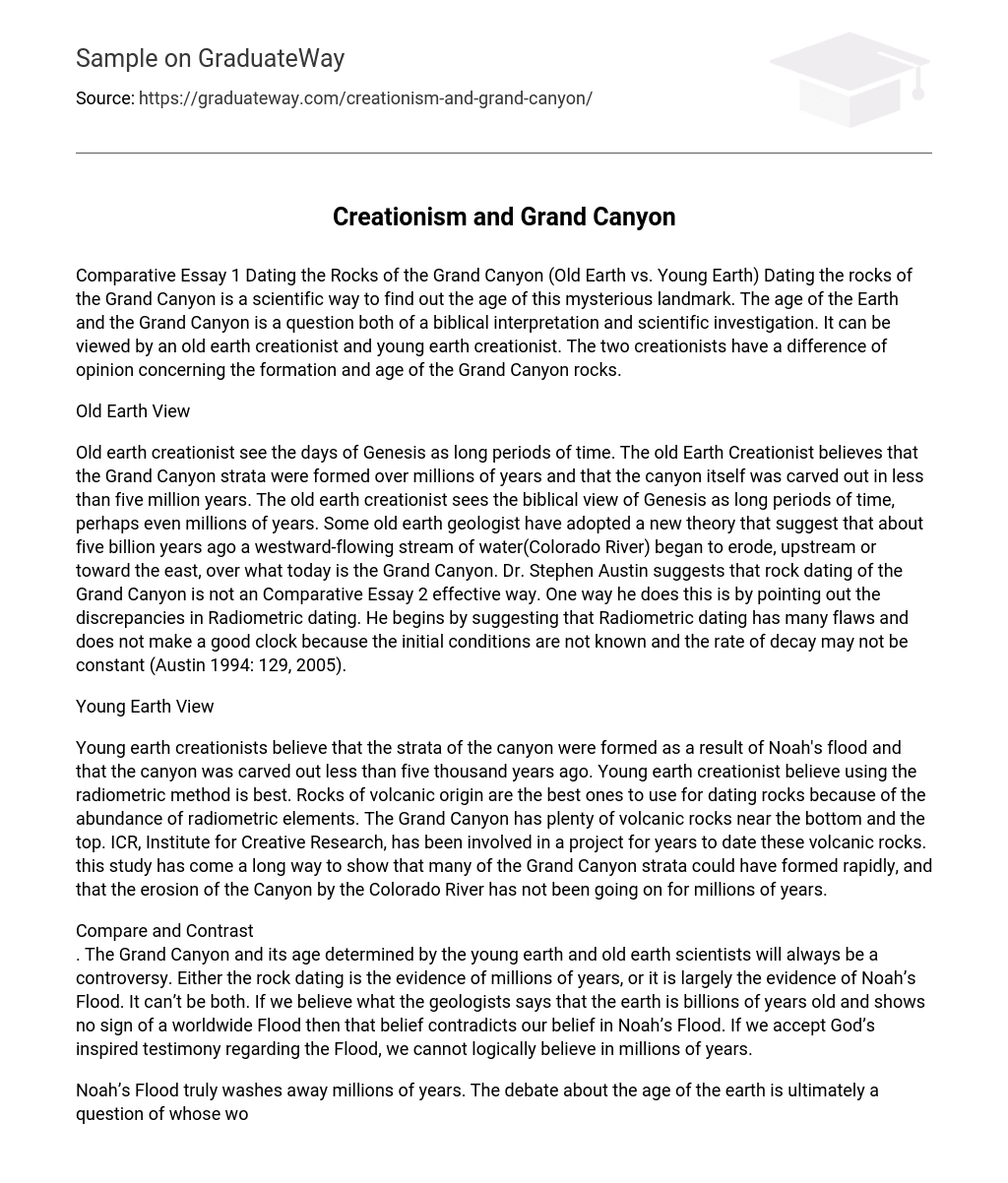Comparative Essay 1 Dating the Rocks of the Grand Canyon (Old Earth vs. Young Earth) Dating the rocks of the Grand Canyon is a scientific way to find out the age of this mysterious landmark. The age of the Earth and the Grand Canyon is a question both of a biblical interpretation and scientific investigation. It can be viewed by an old earth creationist and young earth creationist. The two creationists have a difference of opinion concerning the formation and age of the Grand Canyon rocks.
Old Earth View
Old earth creationist see the days of Genesis as long periods of time. The old Earth Creationist believes that the Grand Canyon strata were formed over millions of years and that the canyon itself was carved out in less than five million years. The old earth creationist sees the biblical view of Genesis as long periods of time, perhaps even millions of years. Some old earth geologist have adopted a new theory that suggest that about five billion years ago a westward-flowing stream of water(Colorado River) began to erode, upstream or toward the east, over what today is the Grand Canyon. Dr. Stephen Austin suggests that rock dating of the Grand Canyon is not an Comparative Essay 2 effective way. One way he does this is by pointing out the discrepancies in Radiometric dating. He begins by suggesting that Radiometric dating has many flaws and does not make a good clock because the initial conditions are not known and the rate of decay may not be constant (Austin 1994: 129, 2005).
Young Earth View
Young earth creationists believe that the strata of the canyon were formed as a result of Noah’s flood and that the canyon was carved out less than five thousand years ago. Young earth creationist believe using the radiometric method is best. Rocks of volcanic origin are the best ones to use for dating rocks because of the abundance of radiometric elements. The Grand Canyon has plenty of volcanic rocks near the bottom and the top. ICR, Institute for Creative Research, has been involved in a project for years to date these volcanic rocks. this study has come a long way to show that many of the Grand Canyon strata could have formed rapidly, and that the erosion of the Canyon by the Colorado River has not been going on for millions of years.
Compare and Contrast
. The Grand Canyon and its age determined by the young earth and old earth scientists will always be a controversy. Either the rock dating is the evidence of millions of years, or it is largely the evidence of Noah’s Flood. It can’t be both. If we believe what the geologists says that the earth is billions of years old and shows no sign of a worldwide Flood then that belief contradicts our belief in Noah’s Flood. If we accept God’s inspired testimony regarding the Flood, we cannot logically believe in millions of years.
Noah’s Flood truly washes away millions of years. The debate about the age of the earth is ultimately a question of whose word we are going to trust, the all-knowing truthful Creator who has given us His book (the Bible) or scientists who give us their books that contain maybe errors and therefore are frequently revised. If you firmly trust and carefully read the Bible and become informed on creationist interpretations of the geological record, you can easily see how the rocks of the earth powerfully confirm the Bible’s teaching, both about Noah’s Flood and a young earth.
Conclusion
The best way to learn about history and the age of the earth is to study the history book of the universe, the Bible. Many old earth and young earth scientists accept a straightforward reading of Scripture and agree that the earth is about 6,000 years old. It is better to use the Word of God for our scientific assumptions than to change His Word in order to compromise with “science” that is based upon man’s assumptions. True science will always support God’s Word.
References
L. Vardiman, A.A. Snelling and E.F. Chaffin (Eds.), Radioisotopes and the Age of the Earth: Results of a Young-Earth Creationist Research Initiative, Institute for Creation Research, Santee, California, and Creation Research Society, St. Joseph, Missouri, 2000. Austin, Steven A. 1994. Grand Canyon: Monument to Catastrophe. Santee, California: Institute for Creation Research.





